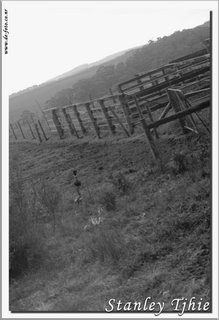Head To Timber

This photo was taken on the way back form Camp Cooriemungle. Jim, the driver spot on those ducklings and its parents on the side of the road. They are called the Mallard duck. I had to shoot through the window as opening the door will let out a loud mechanical sound and I guess would scare the ducks even further. This photo was post processed into black and white.
It also frequents Central America and the Caribbean, and has been introduced into Australia and New Zealand. It is now the most common duck in New Zealand. It is probably the best-known of all ducks.
The breeding male is unmistakable, with a green head, black rear end and a blue speculum edged with white, obvious in flight or at rest. Males also possess a yellow bill with a black tip, whereas females have a dark brown bill. It is a bird of most wetlands, including parks, small ponds and rivers, and usually feeds by dabbling for plant food or grazing. It nests usually on a river bank, but not always particularly near water. This is a noisy species. The male has a nasal call, whereas the female has the very familiar "quack" always associated with ducks.
Mallards form pairs only until the female lays eggs, at which time she is left by the male. The clutch is 9–13 eggs, which are incubated for 27–28 days to hatching with 50–60 days to fledging. The ducklings are precocial, and can swim and feed themselves on insects as soon as they hatch, although they stay near the female for protection. Young ducklings are not naturally waterproof and rely on the mother to provide waterproofing. Mallards also have rates of male-male sexual activity that are unusually high for birds. In some cases, as many as 19% of pairs in a Mallard population are male-male homosexual.
(courtesy wikipedia.com)
It also frequents Central America and the Caribbean, and has been introduced into Australia and New Zealand. It is now the most common duck in New Zealand. It is probably the best-known of all ducks.
The breeding male is unmistakable, with a green head, black rear end and a blue speculum edged with white, obvious in flight or at rest. Males also possess a yellow bill with a black tip, whereas females have a dark brown bill. It is a bird of most wetlands, including parks, small ponds and rivers, and usually feeds by dabbling for plant food or grazing. It nests usually on a river bank, but not always particularly near water. This is a noisy species. The male has a nasal call, whereas the female has the very familiar "quack" always associated with ducks.
Mallards form pairs only until the female lays eggs, at which time she is left by the male. The clutch is 9–13 eggs, which are incubated for 27–28 days to hatching with 50–60 days to fledging. The ducklings are precocial, and can swim and feed themselves on insects as soon as they hatch, although they stay near the female for protection. Young ducklings are not naturally waterproof and rely on the mother to provide waterproofing. Mallards also have rates of male-male sexual activity that are unusually high for birds. In some cases, as many as 19% of pairs in a Mallard population are male-male homosexual.
(courtesy wikipedia.com)




No comments:
Post a Comment